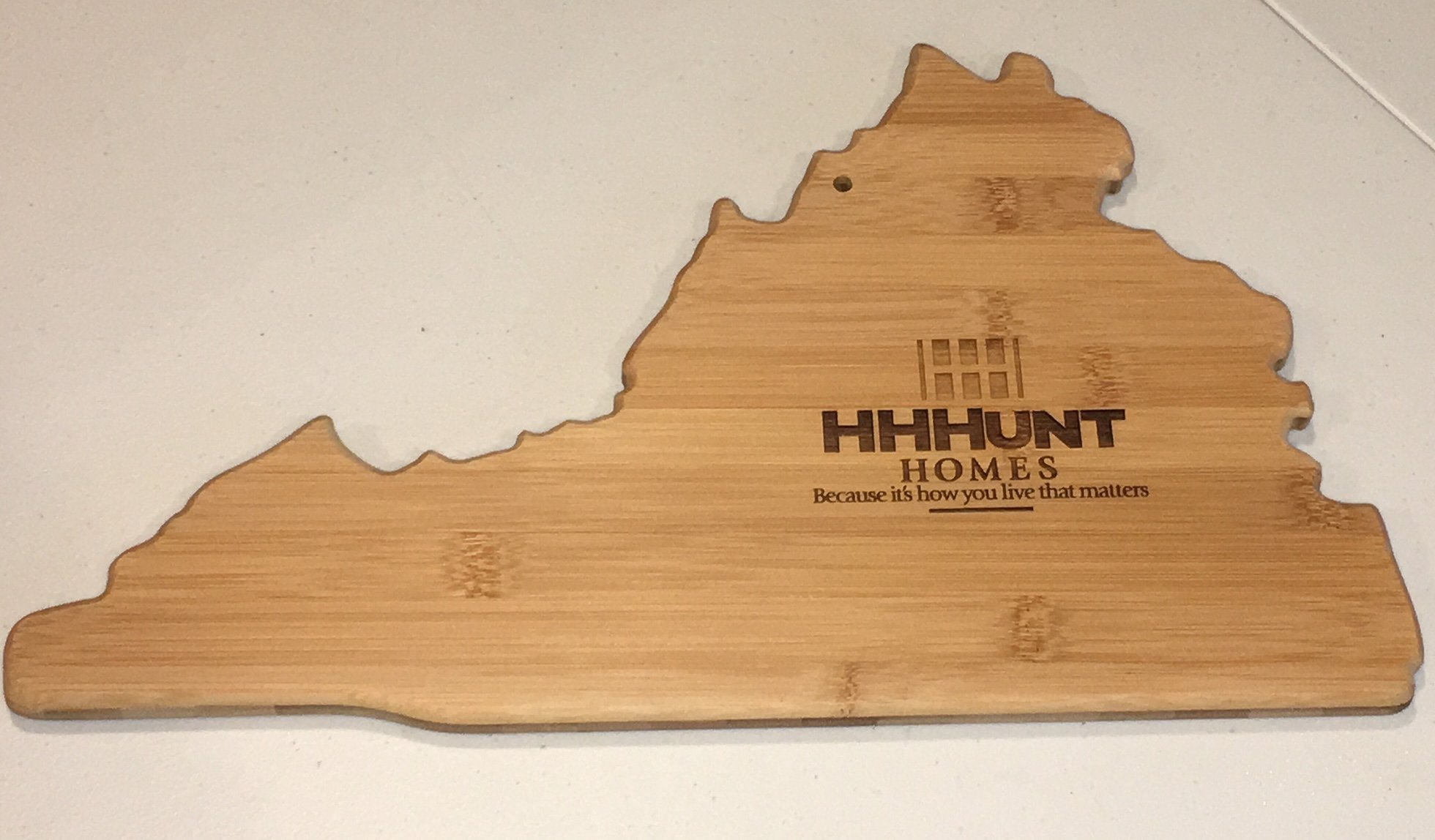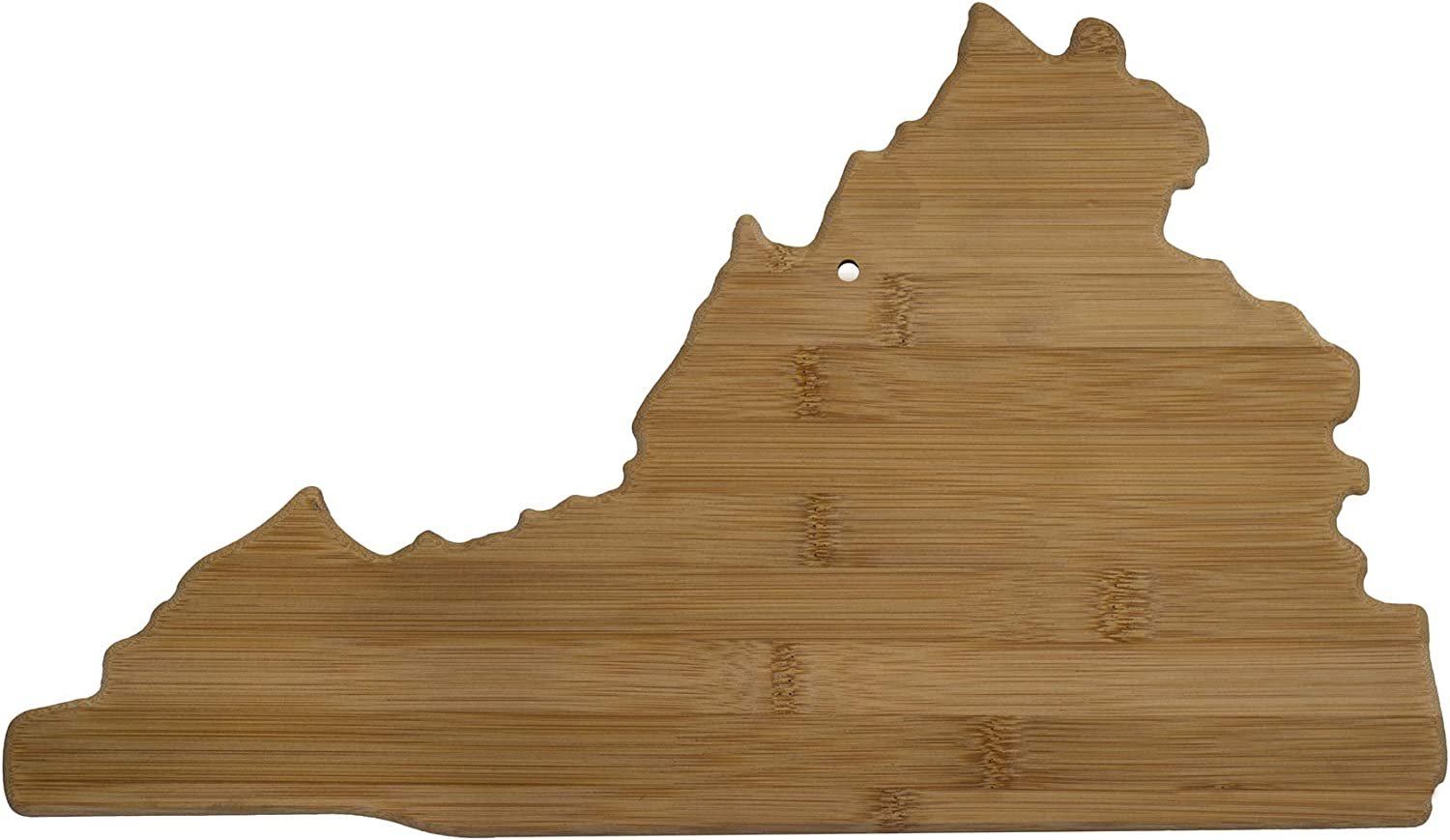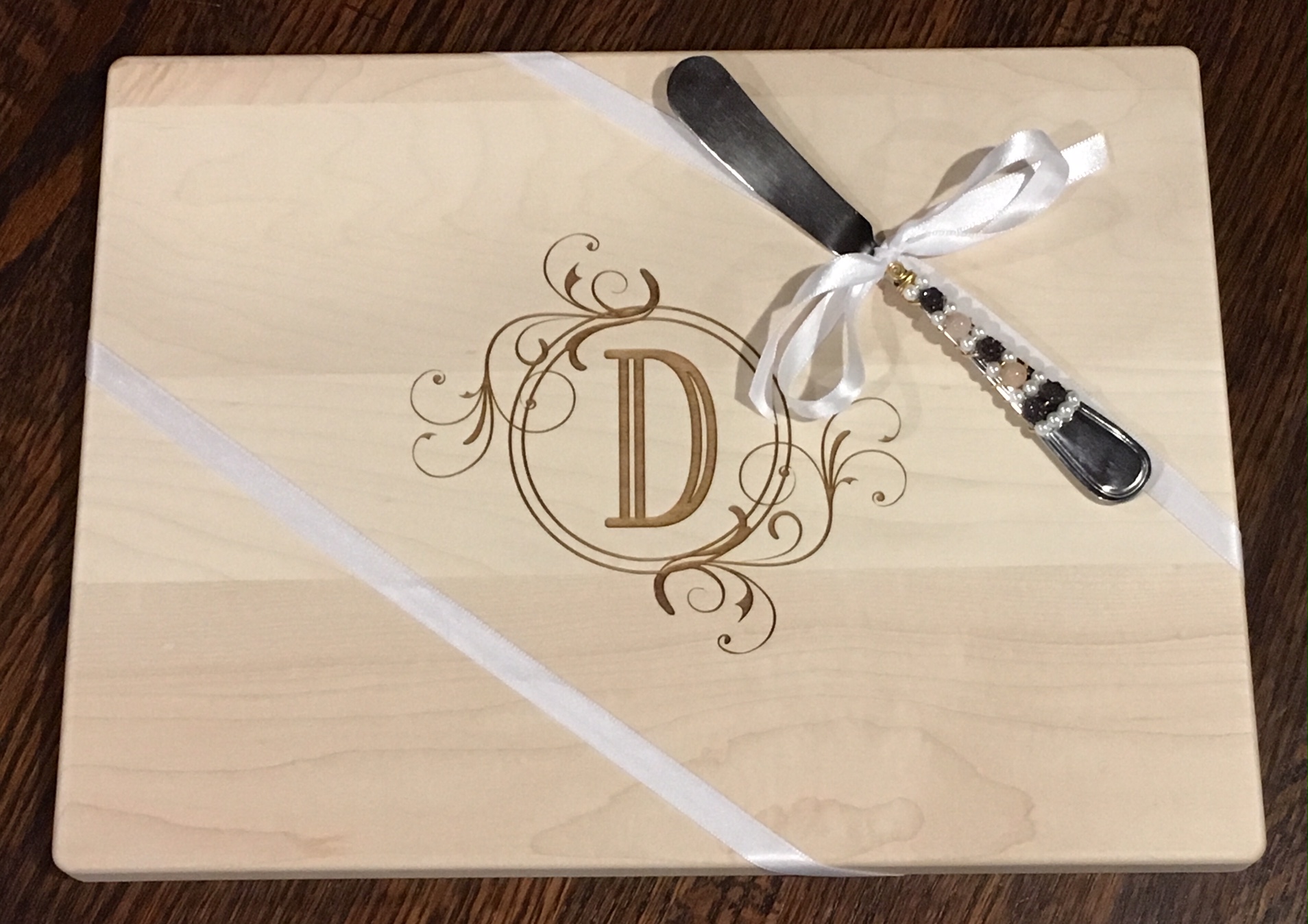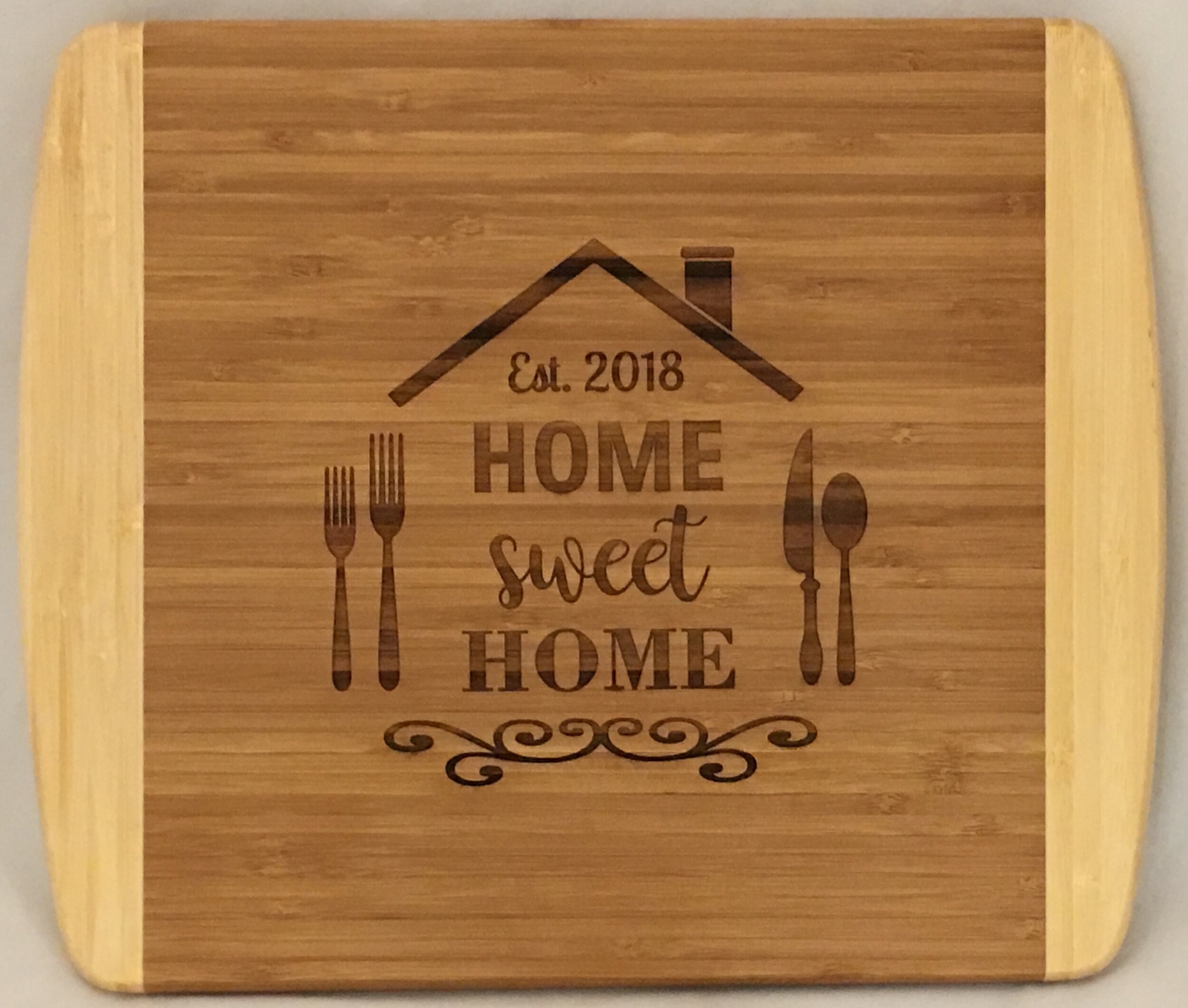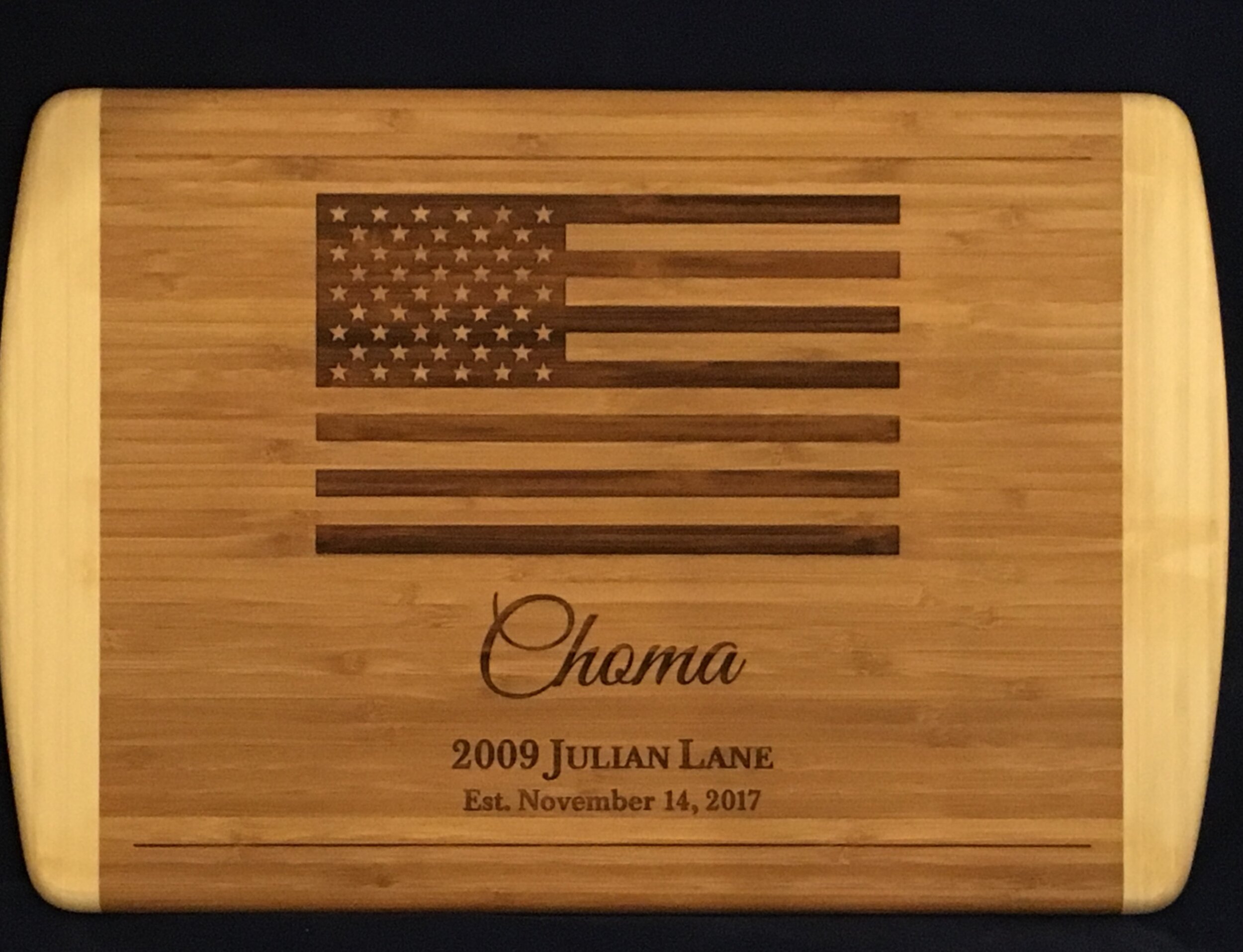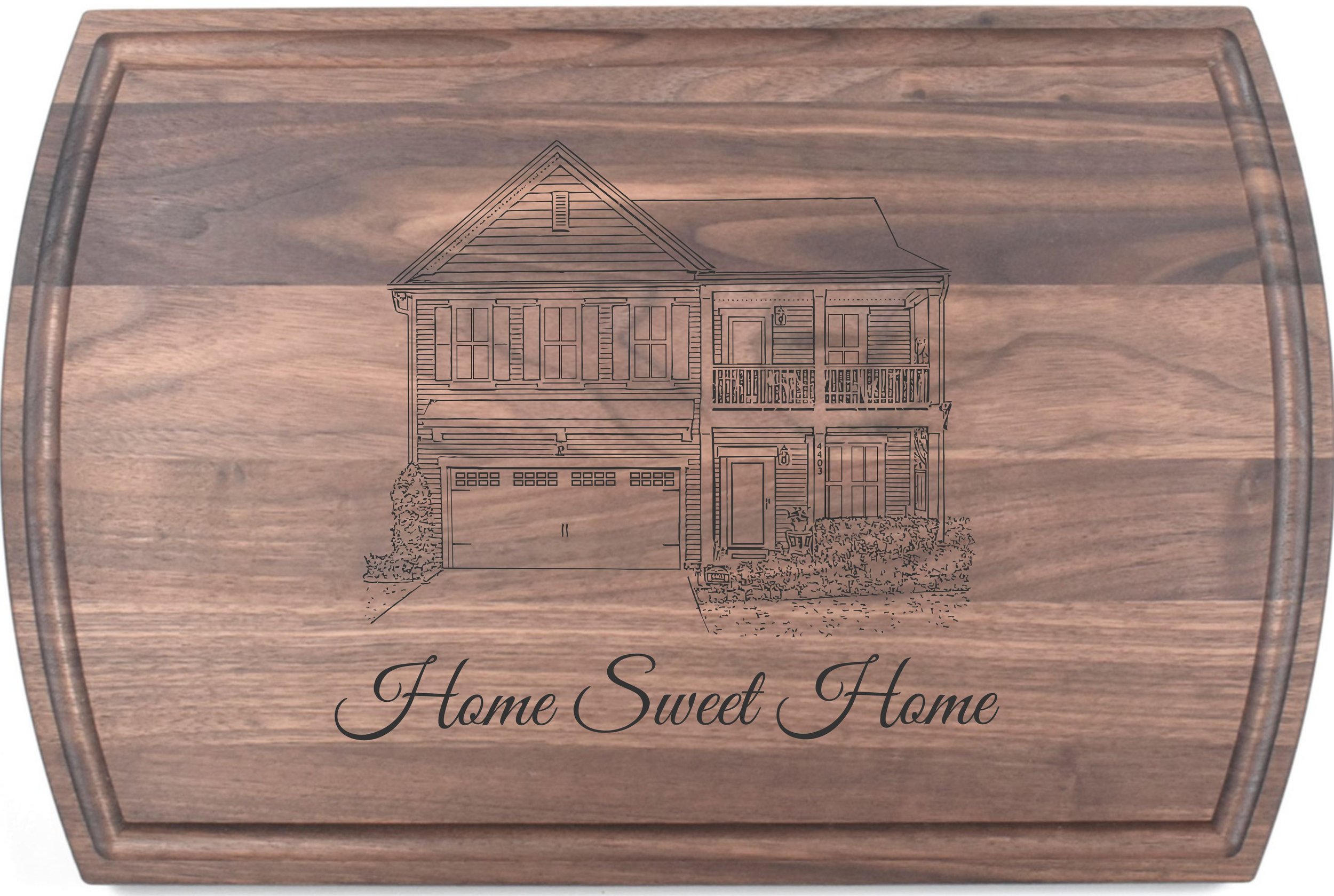
16 x 10.5 inch Walnut Cutting Board with Photo or Recipe
16 x 10.5 inches, 0.75 inch thick
Walnut
Rectangular shaped with its rounded contours with juice groove
Large enough to be used as a carving board, at the counter, and attractive enough to make its way to the table. This rectangular walnut cutting board, with its rounded ends, is a beautiful and functional addition to any kitchen.
Create a one of a kind gift with a house photo or recipe laser engraved on the front or back.
Reversible
This cutting board is reversible. Use the side of the board with the groove when slicing juicy fruit or carving a roast; turn it over, for a completely flat working surface when cutting less messy items such as vegetables, bread, or cheese. Maybe get in the habit of using one side for fresh fruits and vegetables, and the other side for meat.
Care and Maintenance
This beautiful walnut cutting board is easy to maintain, simply wash with warm water, rinse, and let dry. Apply cutting board oil regularly. The cutting board comes with complete care and maintenance instructions.
USA
Our cutting boards are proudly made in the USA, and are designed to be both functional and good looking.

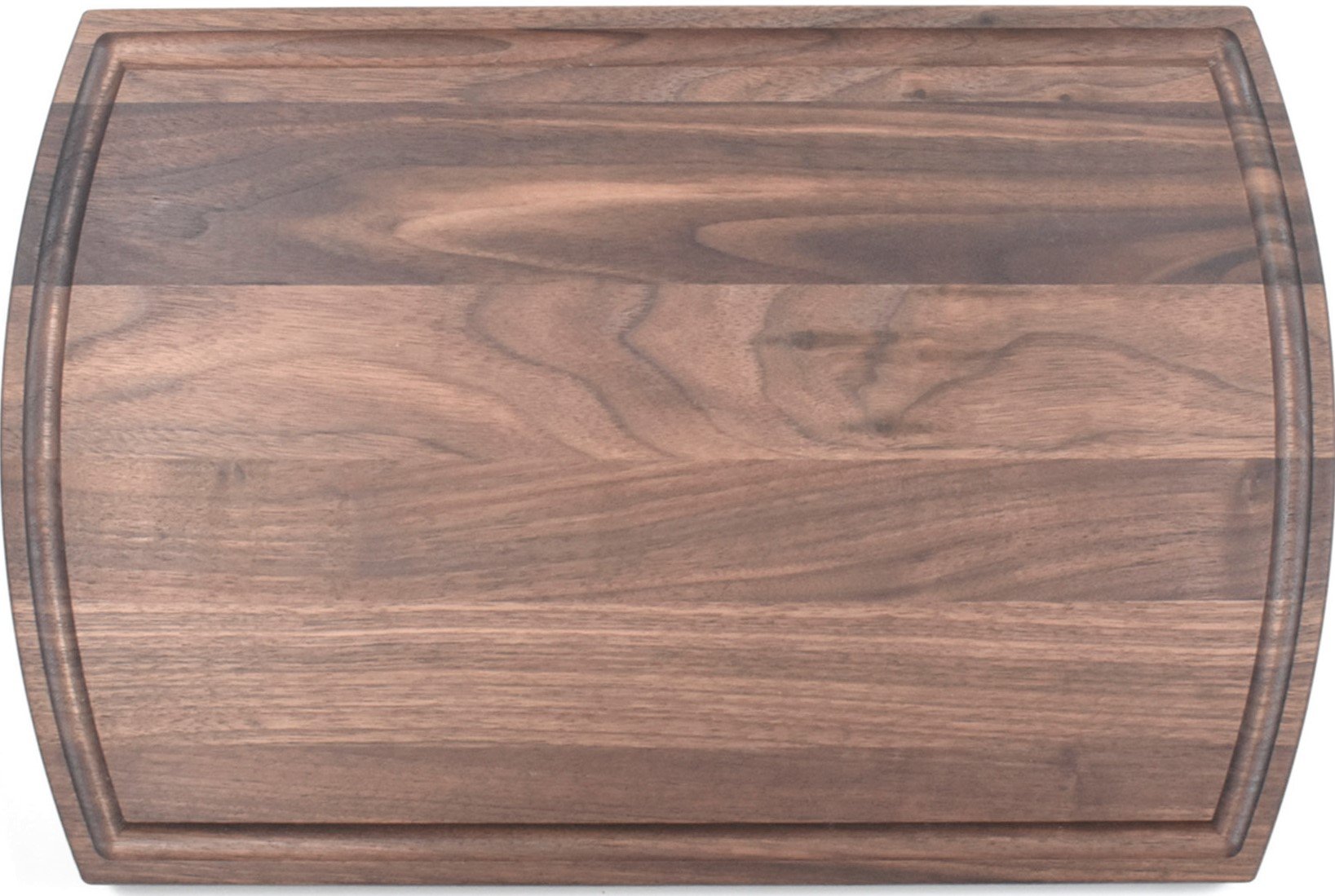
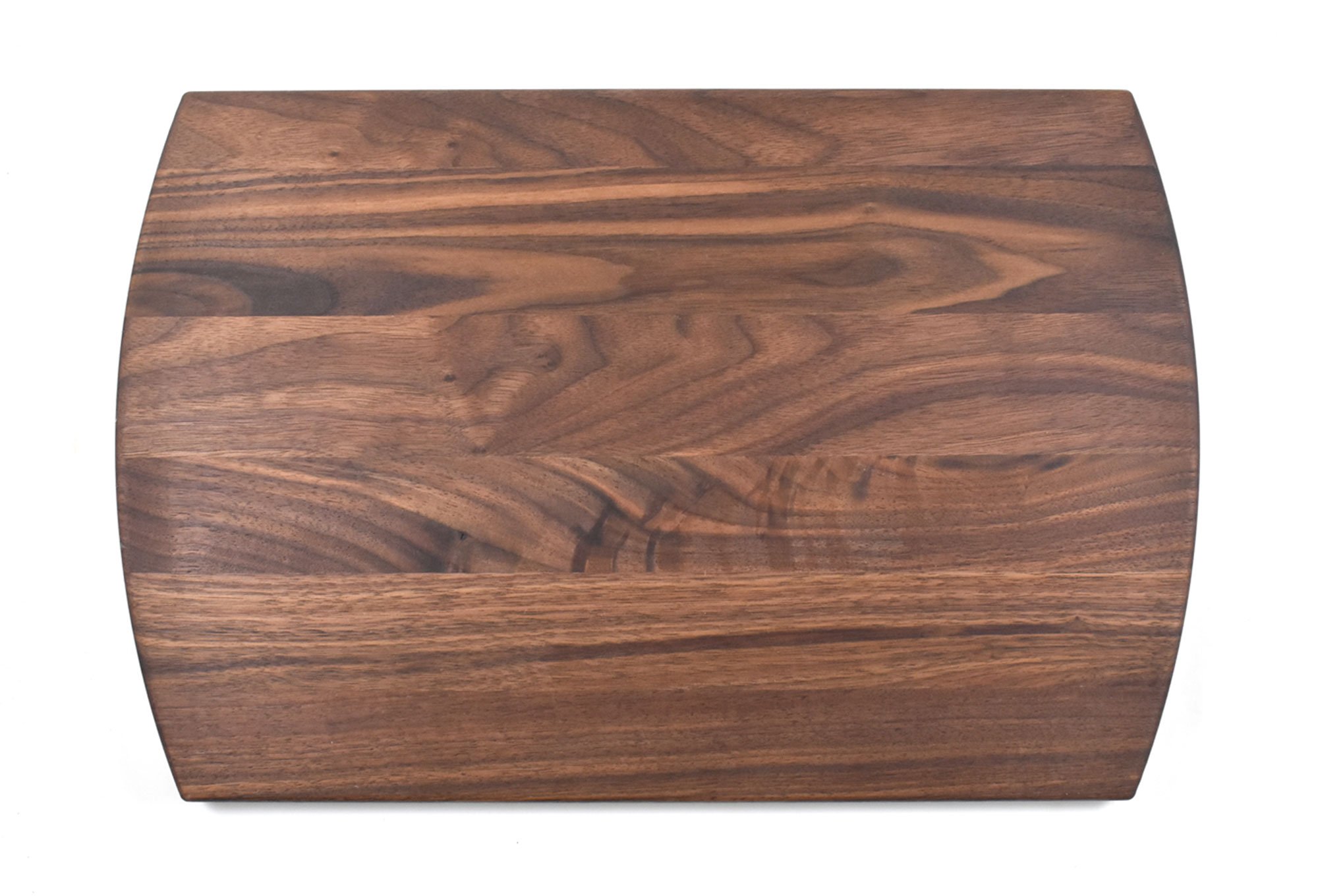
Additional Info
Products Settings
Add Product
Search
Any Stainless Steel Tumbler Engraved
15
1 in Stock
Acrylic Engraved Tumbler
22
1 in Stock
RTIC Powder Coated 30 ounce Tumbler
26
4 in Stock
United States Bottle Cap Holder
50
1 in Stock
Hydroflask Engraving
15
1 in Stock
Large Cutting Board
45
1 in Stock
Hidden
Large Cutting Board with Photo or Recipe
53
1 in Stock
YETI Rambler 20 ounce
45
1 in Stock
YETI Colster
45
1 in Stock
YETI Rambler 30 ounce
55
1 in Stock
YETI Rambler Lowball 10 ounce
35
1 in Stock
North Carolina Bottle Cap Holder
30
1 in Stock
North Carolina Monogram
30
1 in Stock
3 Letter Wooden Monogram with Circle
36
1 in Stock
1 Letter Wooden Monogram with Circle
28
1 in Stock
Holiday Cheese Board with Knife Set
35
1 in Stock
Personalized Hockey Puck
10
1 in Stock
Diploma Plaque
75
1 in Stock
Aluminum Luggage Tag
6
1 in Stock
Heart Monogram
36
1 in Stock
Flip Flop Monogram
30
1 in Stock
3 Letter Monogram Ornament
25
1 in Stock
3 Letter Monogram Bag Tag
25
1 in Stock
Cork Coasters Set of 4
12
1 in Stock
Natural Coco Fiber Door Mat
45
1 in Stock
Champage Flute
13
1 in Stock
Large Pilsner Glass
15
1 in Stock
Stemless Wine Glass
13
1 in Stock
Pint Beverage Glass
13
1 in Stock
Highball Glass
13
1 in Stock
Lowball/Rocks Glass
13
1 in Stock
Ice Cream Scoop
45
1 in Stock
Small Cutting Board
28
1 in Stock
Glass Coasters
19
1 in Stock
Wine Glass
13
1 in Stock
Ceramic Mug
15
8 in Stock
Laser Engraved Pyrex Baking Pan
from 25
2 in Stock
Pyrex Pie Pan
30
1 in Stock
Cork Trivet
10
1 in Stock
Engraved Pencils
from 5
2 in Stock
Engraved Golf Tees
10
1 in Stock
Cotton Placemat
19
1 in Stock
Glass Ball Ornament
10
1 in Stock
Laser Engraved 14 inch Wooden Spoon
5
1 in Stock
Good Grips 14 inch Wooden Spoon
10
1 in Stock
Beer Tap Handle
30
1 in Stock
Skateboard Deck
50
1 in Stock
Bottle Opener
10
1 in Stock
Snowman
25
1 in Stock
Cherry Plaque 8 inch x 10 inch
45
1 in Stock
Goose Monogram
25
1 in Stock
Ornament Monogram
25
1 in Stock
Snowflake Monogram
25
1 in Stock
Star Wars Ornaments
25
1 in Stock
Personalized Baseball
13
1 in Stock
Powder Coated Personalized 30 oz Tumbler
26
1 in Stock
Personalized Hammer
23
1 in Stock
Laser Engraved Shot Glass
7
1 in Stock
Acrylic Stemless Wine Glass
13
1 in Stock
Hidden
Acrylic Serving Tray
40
1 in Stock
Acrylic Coasters Set of Four
33
1 in Stock
YETI Rambler Bottle 64 ounce
85
1 in Stock
YETI Rambler Bottle 36 ounce
65
1 in Stock
YETI Rambler Bottle 18 ounce
45
1 in Stock
Hidden
Powder Coated Personalized 20 oz Tumbler
35
1 in Stock
Hidden
Acrylic Wine Glass
13
1 in Stock
Chick Monogram
15
1 in Stock
BOO Letters
15
1 in Stock
LUCK Sign
from 10
2 in Stock
Rabbit Monogram
25
1 in Stock
Hidden
Bunny Monogram
25
1 in Stock
Hidden
Counties of Ireland Ornament
6
1 in Stock
Four Leaf Clover Mongram
25
1 in Stock
Acrylic Lowball/Rocks Glass
13
1 in Stock
Pumpkin Monogram
25
1 in Stock
Blank Pumpkin
9
1 in Stock
1 Item Selected
Move
Move To Top
Move To Bottom
ItemPricing & VariantsAdditional InfoFormOptionsSocial
Additional Info
Put additional info on your product page: a longer description, videos, or other content.
Wood Cutting Board Care & Maintenance
Wood Cutting Board Care & Maintenance
A wood cutting board is one of the most actively used kitchenware items in your home. In order to keep it looking great, and for it to become a long lasting fixture in your kitchen, it’s important that you give your cutting board the proper care it requires.
Hand-Wash Only, never submerge in water
To avoid bacteria formation, it’s important that you wash your cutting board immediately after use. Wipe the cutting board with hot soapy water, rinse it with hot water only and just wipe it dry with a clean dish towel. Store the cutting board in an upright position and in a dry area.
Important: Wood cutting boards should never be submerged in water, or washed in the dishwasher since this will cause it to warp and crack.
Disinfect & deodorize using vinegar
We recommend keeping a spray bottle of vinegar handy to disinfect & deodorize your wood cutting board. Acetic acid (white vinegar) is an excellent disinfectant that combats E. coli, Salmonella and other household bacteria. Spray vinegar on the wood cutting board, let sit for a few minutes and wipe it with a damp clean cloth.
Remove stains & deodorize with baking soda
You can also combine 2 tablespoons of baking soda, 1 tablespoon of salt and 3 tablespoons hot water to create a non-toxic cleaning agent. Mix these ingredients together to form a paste, and scrub the entire surface of the cutting board. Finally, wipe it with a warm wet cloth and dry with a dish towel.
Clean with coarse salt & lemon
For an all-natural clean, first try dampening the wood cutting board with a warm cloth and sprinkling coarse salt over it. Cut a lemon in half and scour the cut side of the lemon over the board while slightly squeezing the lemon juice out as you go. Let it stand for five minutes and use a scrub brush to remove the excess.
Disinfect using hydrogen peroxide
Hydrogen is a powerful oxidizer that is considered harmless in small amounts. To clean your wooden cutting board, pour 3% hydrogen peroxide on the board and spread it using a clean sponge or cloth. Let it stand for five minutes and then wipe with a warm wet sponge or cloth.
Disinfect using diluted chlorine bleach
Chlorine bleach is best used if you are attempting to sterilize your wooden cutting board after using it to cut raw meat (including fish or poultry). It is safe to use only a single teaspoon of chlorine bleach per quart of water for the purpose of rinsing the board. Let the bleach take action on the bacteria for a few minutes, then rinse with hot water and dry thoroughly.
Refurbishing wood cutting board
It’s hard to avoid knife marks from accumulating on your cutting board over the years. The wonderful thing about a wood board is that it can be returned to its original splendor easily. All you need is three different grits of sand paper (100, 180 and 240 specifically). First sand the board with the coarser 100 grit, then the 180 and finish with the fine 240 grit. Once you are done with sanding, wash the board, let dry and apply oil. See reverse side for the different oils that can be used.
Cut Lightly
When using your wooden cutting board, make sure you pair it with sharp knives that make cutting easy, and apply minimal pressure to avoid creating deep gashes in your wooden cutting board. If your knives are dull, take them in to a professional knife sharpener—you’ll be surprised what a difference sharp knives can make in kitchen prep!
Food Safety Practices
According to U.S. Department of Health & Human Service’s food safety website the main steps to ensuring that your foods are prepared in a safe manner that reduces the risks of getting food poisoning or worse are:
Clean—Wash hands and utensils frequently. Wash fruits and veggies.
Separate—Keep meat, poultry, seafood, and eggs separate from all other foods
Cook—Cooked food is safe once it’s been heated to a high enough temperature to kill bacteria
Chill—Keep your family safe from food poisoning by refrigerating foods promptly
We recommend visiting the food safety website with your family, and brushing up on your food safety knowledge. Nobody wants a round of food poisoning!
Wood Cutting Board Oil Options
Even with light hand washing, eventually cracks can appear if the board is not oiled regularly. Oiling the wood cutting board frequently will also help repel food particles and prevent the board from becoming stained. Our recommendation for occasional use is to oil the board every two months at least, or once or twice a month if used more frequently.
It’s important to make sure that the cutting board is clean and dry before applying any of these oils.
Mineral oil
Mineral oil is the most commonly used option because it is a safe and cost effective way to keep your wood cutting board looking great for years. Food safe mineral oil can be purchase at your local drug store or major retailer.
Apply the mineral oil using a clean cloth and spread evenly over the board. Let the oil set in for a few hours, or even let it set overnight if you can. Afterward, wipe the excess oil off using a dry cloth.
Beeswax and mineral oil combo
You can combine mineral oil and beeswax in order to obtain the penetrating qualities of mineral oil, with the sealing qualities of beeswax.
In a small saucepan, measure 1/4 cup of beeswax (chunked for quicker melting) and 1 cup of mineral oil. Stir constantly on low heat until the beeswax is completely dissolved. If temperature is too high, the beeswax will discolor.
Take off the heat and let stand for a minute, then, pour in a mason jar and let it cool for a few hours, stirring once or twice every hour to make sure it is well blended. If you skip the stirring, the mixture won’t be as homogeneous.
Using a small dollop, rub it on your board with your clean fingers or a clean cotton rag until it disappears and let it soak for 5-15 minutes. With a clean cotton cloth, buff in a circular motion until the finish is smooth.
You’re done! Keep the jar of oil in your pantry until you need to re-oil your boards or wooden spoons. Do not forget to label it!
Coconut oil
If you absolutely require an all-natural solution, and beeswax alone doesn’t give you the desired results, coconut oil makes a good alternative. It doesn’t go rancid as easily as vegetable oil and allergic reactions are rare.
Taking a chunk and warming it between your clean hands and then rubbing it directly on the board or melting it for 15 seconds in the microwave and then rubbing it on your board will condition it; you will need between a teaspoon and a tablespoon to complete the task. Then, let it sit for a few hours or overnight. Wipe the excess oil or reapply. More than one coat may be necessary. The more the wood is dry, the more oil you will need.
You can also add one part beeswax and four parts coconut oil. Place in a small pot, heat on the stove top on low, melt and mix together. Let it cool slightly, and spread it all over the board. If the oil and beeswax hardens, it will melt in your hand.
Avoid vegetable or nut-based oil
Do not use vegetable oil on your cutting board for the simple reason that it will spoil and become rancid. This will leave your wood cutting board with an unpleasant smell that will also noticeably change the taste of the food you are preparing.
Nut and seed based oils (linseed “flax”, tung oil, etc) are less prone to the vegetable oil issues, but some people have sensitive allergies and they can react negatively to trace amounts.
A wood cutting board is one of the most actively used kitchenware items in your home. In order to keep it looking great, and for it to become a long lasting fixture in your kitchen, it’s important that you give your cutting board the proper care it requires.
Hand-Wash Only, never submerge in water
To avoid bacteria formation, it’s important that you wash your cutting board immediately after use. Wipe the cutting board with hot soapy water, rinse it with hot water only and just wipe it dry with a clean dish towel. Store the cutting board in an upright position and in a dry area.
Important: Wood cutting boards should never be submerged in water, or washed in the dishwasher since this will cause it to warp and crack.
Disinfect & deodorize using vinegar
We recommend keeping a spray bottle of vinegar handy to disinfect & deodorize your wood cutting board. Acetic acid (white vinegar) is an excellent disinfectant that combats E. coli, Salmonella and other household bacteria. Spray vinegar on the wood cutting board, let sit for a few minutes and wipe it with a damp clean cloth.
Remove stains & deodorize with baking soda
You can also combine 2 tablespoons of baking soda, 1 tablespoon of salt and 3 tablespoons hot water to create a non-toxic cleaning agent. Mix these ingredients together to form a paste, and scrub the entire surface of the cutting board. Finally, wipe it with a warm wet cloth and dry with a dish towel.
Clean with coarse salt & lemon
For an all-natural clean, first try dampening the wood cutting board with a warm cloth and sprinkling coarse salt over it. Cut a lemon in half and scour the cut side of the lemon over the board while slightly squeezing the lemon juice out as you go. Let it stand for five minutes and use a scrub brush to remove the excess.
Disinfect using hydrogen peroxide
Hydrogen is a powerful oxidizer that is considered harmless in small amounts. To clean your wooden cutting board, pour 3% hydrogen peroxide on the board and spread it using a clean sponge or cloth. Let it stand for five minutes and then wipe with a warm wet sponge or cloth.
Disinfect using diluted chlorine bleach
Chlorine bleach is best used if you are attempting to sterilize your wooden cutting board after using it to cut raw meat (including fish or poultry). It is safe to use only a single teaspoon of chlorine bleach per quart of water for the purpose of rinsing the board. Let the bleach take action on the bacteria for a few minutes, then rinse with hot water and dry thoroughly.
Refurbishing wood cutting board
It’s hard to avoid knife marks from accumulating on your cutting board over the years. The wonderful thing about a wood board is that it can be returned to its original splendor easily. All you need is three different grits of sand paper (100, 180 and 240 specifically). First sand the board with the coarser 100 grit, then the 180 and finish with the fine 240 grit. Once you are done with sanding, wash the board, let dry and apply oil. See reverse side for the different oils that can be used.
Cut Lightly
When using your wooden cutting board, make sure you pair it with sharp knives that make cutting easy, and apply minimal pressure to avoid creating deep gashes in your wooden cutting board. If your knives are dull, take them in to a professional knife sharpener—you’ll be surprised what a difference sharp knives can make in kitchen prep!
Food Safety Practices
According to U.S. Department of Health & Human Service’s food safety website the main steps to ensuring that your foods are prepared in a safe manner that reduces the risks of getting food poisoning or worse are:
Clean—Wash hands and utensils frequently. Wash fruits and veggies.
Separate—Keep meat, poultry, seafood, and eggs separate from all other foods
Cook—Cooked food is safe once it’s been heated to a high enough temperature to kill bacteria
Chill—Keep your family safe from food poisoning by refrigerating foods promptly
We recommend visiting the food safety website with your family, and brushing up on your food safety knowledge. Nobody wants a round of food poisoning!
Wood Cutting Board Oil Options
Even with light hand washing, eventually cracks can appear if the board is not oiled regularly. Oiling the wood cutting board frequently will also help repel food particles and prevent the board from becoming stained. Our recommendation for occasional use is to oil the board every two months at least, or once or twice a month if used more frequently.
It’s important to make sure that the cutting board is clean and dry before applying any of these oils.
Mineral oil
Mineral oil is the most commonly used option because it is a safe and cost effective way to keep your wood cutting board looking great for years. Food safe mineral oil can be purchase at your local drug store or major retailer.
Apply the mineral oil using a clean cloth and spread evenly over the board. Let the oil set in for a few hours, or even let it set overnight if you can. Afterward, wipe the excess oil off using a dry cloth.
Beeswax and mineral oil combo
You can combine mineral oil and beeswax in order to obtain the penetrating qualities of mineral oil, with the sealing qualities of beeswax.
In a small saucepan, measure 1/4 cup of beeswax (chunked for quicker melting) and 1 cup of mineral oil. Stir constantly on low heat until the beeswax is completely dissolved. If temperature is too high, the beeswax will discolor.
Take off the heat and let stand for a minute, then, pour in a mason jar and let it cool for a few hours, stirring once or twice every hour to make sure it is well blended. If you skip the stirring, the mixture won’t be as homogeneous.
Using a small dollop, rub it on your board with your clean fingers or a clean cotton rag until it disappears and let it soak for 5-15 minutes. With a clean cotton cloth, buff in a circular motion until the finish is smooth.
You’re done! Keep the jar of oil in your pantry until you need to re-oil your boards or wooden spoons. Do not forget to label it!
Coconut oil
If you absolutely require an all-natural solution, and beeswax alone doesn’t give you the desired results, coconut oil makes a good alternative. It doesn’t go rancid as easily as vegetable oil and allergic reactions are rare.
Taking a chunk and warming it between your clean hands and then rubbing it directly on the board or melting it for 15 seconds in the microwave and then rubbing it on your board will condition it; you will need between a teaspoon and a tablespoon to complete the task. Then, let it sit for a few hours or overnight. Wipe the excess oil or reapply. More than one coat may be necessary. The more the wood is dry, the more oil you will need.
You can also add one part beeswax and four parts coconut oil. Place in a small pot, heat on the stove top on low, melt and mix together. Let it cool slightly, and spread it all over the board. If the oil and beeswax hardens, it will melt in your hand.
Avoid vegetable or nut-based oil
Do not use vegetable oil on your cutting board for the simple reason that it will spoil and become rancid. This will leave your wood cutting board with an unpleasant smell that will also noticeably change the taste of the food you are preparing.
Nut and seed based oils (linseed “flax”, tung oil, etc) are less prone to the vegetable oil issues, but some people have sensitive allergies and they can react negatively to trace amounts.
Text
Remove

